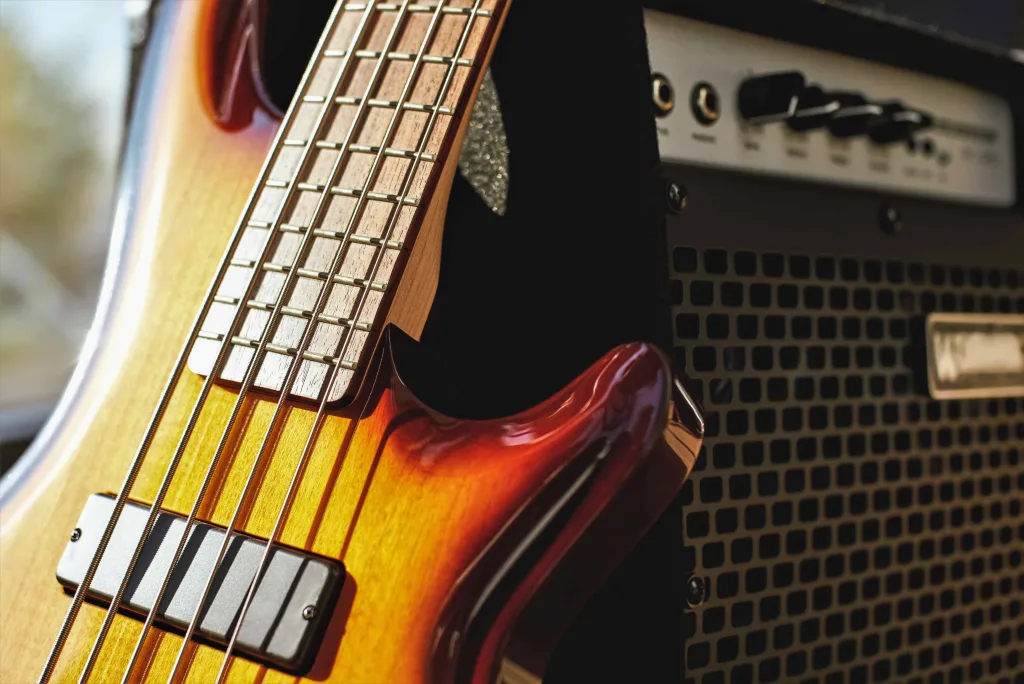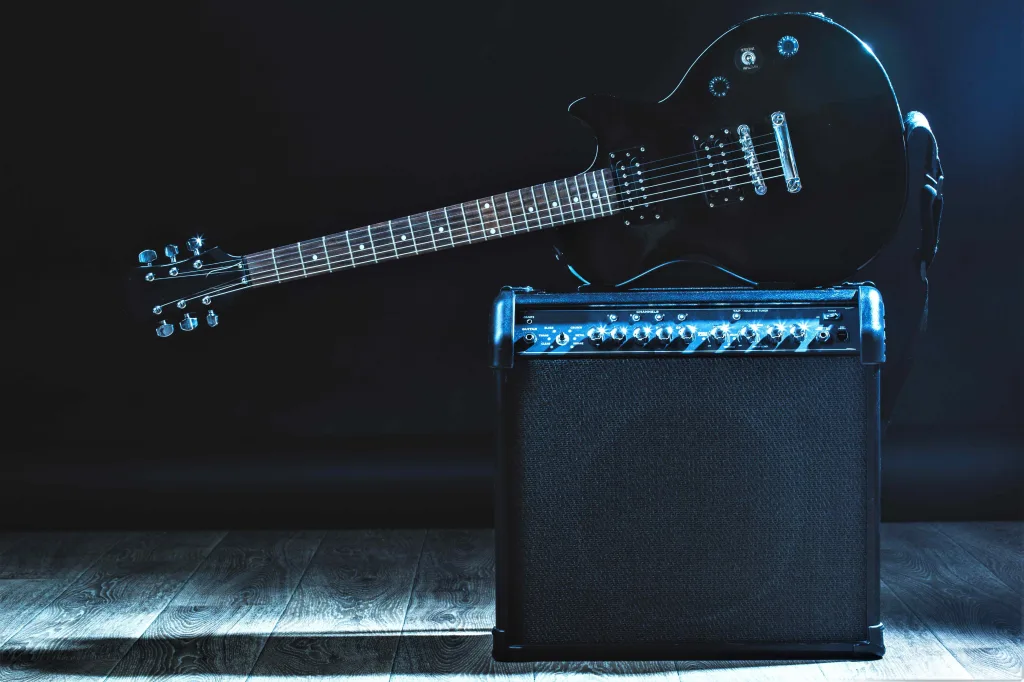Whether you’re into rock, blues, or metal, feedback can add an edge to your sound and help you stand out from the crowd.
While some guitarists shy away from feedback because they see it as uncontrollable or unwanted noise, others embrace it as an artistic tool that adds expression and emotion to their playing.
If you want to join the latter camp and learn how to get controlled feedback on your guitar, read on for our step-by-step guide.
What is guitar feedback?
What is guitar feedback, exactly?
Guitar feedback is caused by the sound waves from your amplifier interacting with the magnetic field of your pickups, resulting in a sustained tone that can last for several seconds. This is why you can manipulate the amount of feedback you get by adjusting the proximity and angle of your electric guitar to the amp.
Another type of feedback that’s common among guitar players is microphonic feedback. This happens when there’s a mechanical problem with your pickups or wiring, causing unwanted noise and squealing during play.
But don’t worry! There are ways to prevent and fix this issue, which we’ll cover in the next section.
Microphonic feedback
Microphonic feedback happens when the vibrations from your guitar strings are picked up by the pickups on your instrument and amplified through your amplifier, creating a high-pitched squeal or screeching noise.
We have some tips to help you control this type of feedback:
Adjust pickup height
The closer the pickups are to the strings, the more likely they will pick up unwanted vibrations. Try lowering them slightly to reduce feedback.
Use a noise gate
A noise gate is an effect pedal that cuts off sound below a certain volume threshold. This can be useful for reducing background noise and taming feedback.
Experiment with EQ settings
Certain frequencies can be more prone to causing feedback than others. By adjusting your amp’s EQ settings, you may be able to find a sweet spot that reduces unwanted noise.
By implementing these tips, you can better manage microphonic feedback and ensure your playing is free from annoying interruptions.
Now let’s explore what gear you need to create guitar feedback.
What gear do you need to create guitar feedback?
To generate the desired guitar feedback effect, you must have a specific set of equipment.
Guitar amplifier with high gain and distortion
To generate guitar feedback, you require an amplifier that can deliver high gain and distortion. The higher the gain, the easier it is to create feedback.
Guitar with sensitive pickups
Choose a guitar with pickups that are sensitive enough to pick up the sound waves produced by your amplifier. Humbucker pickups are known for their ability to pick up more vibrations than single-coil pickups, making them suitable for generating feedback.
Pedal or effect for sustain and additional gain
Use a pedal or effect in your signal chain that can sustain notes and add extra gain. A compressor pedal is particularly helpful in achieving this effect by compressing the dynamic range of your signal and providing sustain.
Good quality cable
Ensure you have a high-quality cable to maintain signal integrity and minimize unwanted interference.
Noise gate
Consider using a noise gate to control unwanted interference, such as hum or buzz, and achieve cleaner and more controlled feedback. By the way it is a common issue for your electric guitar to buzz while you are not touching the strings – check this article on how to fix it.
Step-by-step guide on how to get controlled feedback

Before starting with the steps, make sure your amp is facing away from you and towards a solid surface.
Set up your amp and guitar
If you want to get some serious feedback on your guitar, there are a few key steps you’ll need to take.
Increase the volume on your amp
Turn up the volume on your amp and listen for some hiss or hum coming out when your guitar is plugged in. This means that the signal is starting to break up and feedback, which is exactly what you want.
Experiment with different volume levels until you find the right one that’ll give you the amount of feedback that suits your style.
Increase the volume of your guitar
Once you’ve set the volume on your amp to loud, it’s time to turn up the volume on your guitar.
It’s important to note that when we say feedback, we’re not talking about the unpleasant screeching noise that can sometimes occur when a guitar is too close to an amp.
Instead, we’re referring to the controlled and intentional use of feedback as an effect in your playing.
By turning up your guitar’s volume knob, you’ll be able to create a wall of sound that will add depth and texture to your playing.
Rise the treble settings on your amp and guitar
You’ll love the extra brightness and texture in your sound when you boost the treble settings on both your amp and guitar. Higher treble settings are notorious for producing more feedback, so it’s essential to increase your treble to set yourself up for making the most feedback possible.
If you’re unsure about which direction boosts the treble, plug your guitar in and play a few notes while turning the tone knob. If the sound is getting thinner and crispier, then you’re boosting the treble. On the other hand, if it’s getting deeper, then you’re boosting bass.
Dialing back your bass settings a bit can also help produce more feedback. Remember that treble-heavy tones work best when looking to achieve this effect.
To take things further, read on about how to distort your guitar tone by turning up the amp gain without losing control of it.
Distort your guitar’s tone
The gain knob on your amp controls the level of distortion or overdrive in the signal, which helps produce more feedback.
You’ll need to turn it at least halfway up for a dramatic and pronounced effect, depending on the sound you’re going for. If your amp doesn’t have a gain knob, you could also use a distortion or overdrive pedal to boost your signal even more.
This technique is especially useful if you play heavy metal or hard rock since you can combine both the pedal and amp’s gain settings for very heavy tones.
Keep in mind that while clean tones may still produce some feedback, they won’t be as powerful as when using distorted ones. Now that you have a gritty tone thanks to cranking up the gain knob, let’s move on to producing and manipulating the feedback in other ways without losing control of your sound.
If you are eager to experiment with your sound, you may want to split your amp signal as well.
Creating and controlling the feedback

Alright, let’s dive into producing and manipulating that sweet feedback sound.
Playing close to your amp
Staying as close to your amp as possible is the key to producing feedback on your guitar.
As mentioned earlier, you don’t even have to hit any notes or chords to get feedback – just standing close enough will do the trick.
But if you want to manipulate the sound further, try moving around while playing and see how your guitar responds. Once you find a sweet spot where the feedback level is just right for you, stay there and enjoy the ride.
Playing away from your amp
Hit any note or chord while facing away from the amp and let it sustain for a few seconds.
The key to getting great feedback is to experiment with different notes and chords, as well as different distances from the amp. Try moving closer or farther away, or even moving around the room to see how the sound changes. As you play around with feedback, you’ll start to develop a feel for what works best for your playing style.
Creating feedback swirls
Once you’ve hit the note, physically turn your body to face the amp while keeping the note ringing.
Make sure to press your guitar pickups right up to the amp speakers without actually touching them, as this will overdrive your signal and produce a ton of feedback.
Exploring tonal variations
Each movement of your guitar causes different frequencies to be emphasized or canceled out, resulting in an ever-changing feedback effect.
You can experiment with pointing the headstock up towards the ceiling or down towards the floor, tilting it sideways, or even doing circular motions.
The closer you get to the amp, the more intense the feedback will be.
Once you’ve found a sweet spot where you like the tone, try adding some vibrato to sustain the note and increase its volume. This’ll further excite the strings and create even more harmonic overtones that contribute to that signature screeching sound.
Enhance feedback with vibrato
Vibrato adds depth and dimension to the notes, making them more interesting and dynamic. It’s a powerful tool that every guitarist should master if they want to take their playing to the next level.
Generating feedback at lower volumes
A distortion pedal could produce a lot of feedback at lower volumes, but not all pedals are designed to boost feedback.
Once you’ve set up your feedback pedal, use it with other techniques, such as vibrato on notes and bending strings for added depth and emotion.
Extend feedback with a compressor pedal
Using a compressor pedal can be very helpful. They even out the volume of your guitar by making quieter notes louder and louder notes quieter.
This means that when you play a note that creates feedback, it will sound amplified and last longer than without the pedal. So instead of raising the volume on your amp to get sustained feedback, you can use a compressor pedal to achieve this effect at lower volumes.
It’s important to note that while compressors are great for creating sustain and enhancing certain aspects of your tone, they do add some noise into the signal chain, which could lead to more feedback overall. However, with proper use and technique, a compressor pedal can be invaluable in getting the sustained feedback that makes a guitar sing just the right way.
Conclusion
With the right gear and technique, you can add a whole new dimension to your playing and truly make your instrument sing.
As you experiment with different levels of distortion, gain, and volume, remember that feedback is not just about being loud – it’s about using sound as a tool for expression.
Whether you’re using it to accentuate a solo or create an atmospheric backdrop for a song, feedback can be a powerful ally in your musical arsenal.
Related articles:

